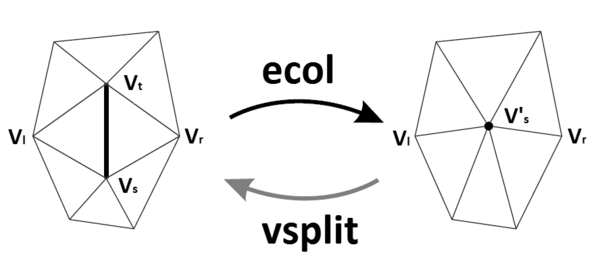Progressive meshes
Progressive meshes is one of the techniques of dynamic level of detail (LOD). This technique was introduced by Hugues Hoppe in 1996.[1] This method uses saving a model to the structure - the progressive mesh, which allows a smooth choice of detail levels depending on the current view. Practically, this means that it is possible to display whole model with the lowest level of detail at once and then it gradually shows even more details. Among the disadvantages belongs considerable memory consumption. The advantage is that it can work in real time. Progressive meshes could be used also in other areas of computer technology such as a gradual transfer of data through the Internet or compression. [2]
Basic principle
A progressive mesh is a data structure which is created as the original model of the best quality simplifies a suitable decimation algorithm, which removes step by step some of the edges in the model (edge-collapse operation). It is necessary to undertake as many simplifications as needed to achieve the minimal model. The resultant model, in a full quality, is then represented by the minimal model and by the sequence of inverse operations to simplistic (vertex split operation). This forms a hierarchical structure which helps to create a model in the chosen level of detail.
Edge collapse
This simplistic operation - ecol takes two connected vertices and replaces them with a single vertex. Two triangles {vs, vt, vl} and {vt, vs, vr} which were connected by the edge are also removed during this operation.
Vertex split
Vertex split (vsplit) is the inverse operation to the edge collapse that divides the vertex into two new vertices. Therefore, a new edge {vt, vs} and two new triangles {vs, vt, vl} and {vt, vs, vr} arise.
References
- ↑ Hoppe, Hugues (1996). "Progressive meshes". Proceedings of the 23rd annual conference on Computer graphics and interactive techniques. New York, New York, USA: ACM Press. pp. 99–108. doi:10.1145/237170.237216. ISBN 0-89791-746-4.
- ↑ D. Luebke, M. Reddy, J. D. Cohen, A. Varshney, B. Watson, R. Huebner: Level of Detail for 3D Graphics, Morgan Kaufmann, 2002, ISBN:0-321-19496-9
 |


